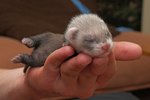
The genus Marmota includes all of the world's 14 marmot species, making them all fairly closely related to each other. These medium to large rodents live in the Northern Hemisphere and all share certain features and characteristics. Some characteristics differ between species, however. For example, several species are social creatures while others, including the woodchuck, are solitary.
Close Relatives
The closest relatives to any marmot are other marmots in the genus Marmota. Other close relatives include ground squirrels and prairie dogs. As sciurid rodents, they're more closely related to other types of squirrels than to rodents such as rats, mice, beavers or gophers.
Size
While size varies greatly between the different species of marmots, most are about the size of a large house cat. The yellow-bellied marmot (Marmota flaviventris) ranges in weight from around 3.5 to 11.5 pounds. The woodchuck (Marmota monax) can weigh more than 13 pounds and be well over 2 feet long. Other species stay within this range, such as the bobak marmot, which grows to between 19 and 23 inches long.
Diet
In general, marmots tend to be herbivores, eating different types of plant material to stay alive. A few species such as woodchucks, however, will supplement their diets with insects and bird eggs. Common sources of food include grasses, hays, herbs, dandelions and seeds. Dietary preferences often change throughout the seasons to accommodate the marmots' fat needs and food availability.
Other Characteristics
All marmots closely resemble each other with a few differences in color, coat and size. All have similarly shaped bodies with short legs, long, thick bodies, short ears and teeth reminiscent of most rodents. Each marmot species has the ability to make a whistling noise used to warn others or try to ward off predators; they may also use these whistles as other methods of communication among each other. In addition, all marmots are true hibernators that spend much of the coldest months in a deep sleep.
References
- University of Michigan Animal Diversity Web: Marmota Classification
- University of Michigan Animal Diversity Web: Marmota Flaviventris
- University of Michigan Animal Diversity Web: Marmota Monax
- University of Michigan Animal Diversity Web: Marmota Bobak
- University of Michigan Animal Diversity Web: Marmota Caligata
- University of Michigan Animal Diversity Web: Marmota Sibirica
Photo Credits
-
Jupiterimages/Photos.com/Getty Images
Writer Bio
With a professional background in gardening, landscapes, pests and natural ecosystems, Jasey Kelly has been sharing her knowledge through writing since 2009 and has served as an expert writer in these fields. Kelly's background also includes childcare, and animal rescue and care.




